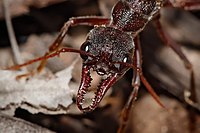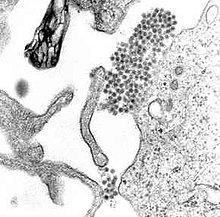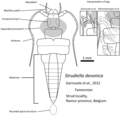The Insects Portal


Insects (from Latin insectum) are hexapod invertebrates of the class Insecta. They are the largest group within the arthropod phylum. Insects have a chitinous exoskeleton, a three-part body (head, thorax and abdomen), three pairs of jointed legs, compound eyes, and a pair of antennae. Insects are the most diverse group of animals, with more than a million described species; they represent more than half of all animal species. (Full article...)
Selected article -
Dengue virus (DENV) is the cause of dengue fever. It is a mosquito-borne, single positive-stranded RNA virus of the family Flaviviridae; genus Flavivirus. Four serotypes of the virus have been found, and a reported fifth has yet to be confirmed, all of which can cause the full spectrum of disease. Nevertheless, scientists' understanding of dengue virus may be simplistic as, rather than distinct antigenic groups, a continuum appears to exist. This same study identified 47 strains of dengue virus. Additionally, coinfection with and lack of rapid tests for Zika virus and chikungunya complicate matters in real-world infections.
Dengue virus has increased dramatically within the last 20 years, becoming one of the worst mosquito-borne human pathogens that tropical countries have to deal with. 2013 estimates indicate that as many as 390 million infections occur each year, and many dengue infections are increasingly understood to be asymptomatic or subclinical. (Full article...)Did you know -
- ... that the seeds of the European sedge Carex pilulifera may be dispersed by the ant Myrmica ruginodis?
- ... that the oldest known member of the mayfly family Neoephemeridae is the Eocene species Neoephemera antiqua?
- ... that Sphecius grandis, the Western cicada killer wasp, paralyzes cicadas for its offspring to eat after hatching?
- ... that the extinct griffenfly genus Bohemiatupus inhabited peat-mires?
- ... that the extinct hangingfly genera Formosibittacus, Jurahylobittacus, and Mongolbittacus are only known from the Middle Jurassic of China?
List articles
Related portals
General images -
Selected image -

Simosyrphus grandicornis is an Australasian species of hoverfly (Diptera: Syrphidae), and is one of the two most common hoverflies in Australia, alongside Melangyna viridiceps. Pictured above is a pair of S. grandicornis mating in flight.
WikiProjects

Main WikiProject:
Related projects:
- WikiProject Arthropods
- WikiProject Spiders
- WikiProject Animals
- WikiProject Tree of Life
- WikiProject Biology
Daughter projects:
Tasks
 |
Here are some tasks awaiting attention:
|
Associated Wikimedia
The following Wikimedia Foundation sister projects provide more on this subject:
-
 Commons
Commons
Free media repository -
 Wikibooks
Wikibooks
Free textbooks and manuals -
 Wikidata
Wikidata
Free knowledge base -
 Wikinews
Wikinews
Free-content news -
 Wikiquote
Wikiquote
Collection of quotations -
 Wikisource
Wikisource
Free-content library -
 Wikiversity
Wikiversity
Free learning tools -
 Wiktionary
Wiktionary
Dictionary and thesaurus
-

-

-

-

-
Random portal
Purge server cache










































Recent Comments